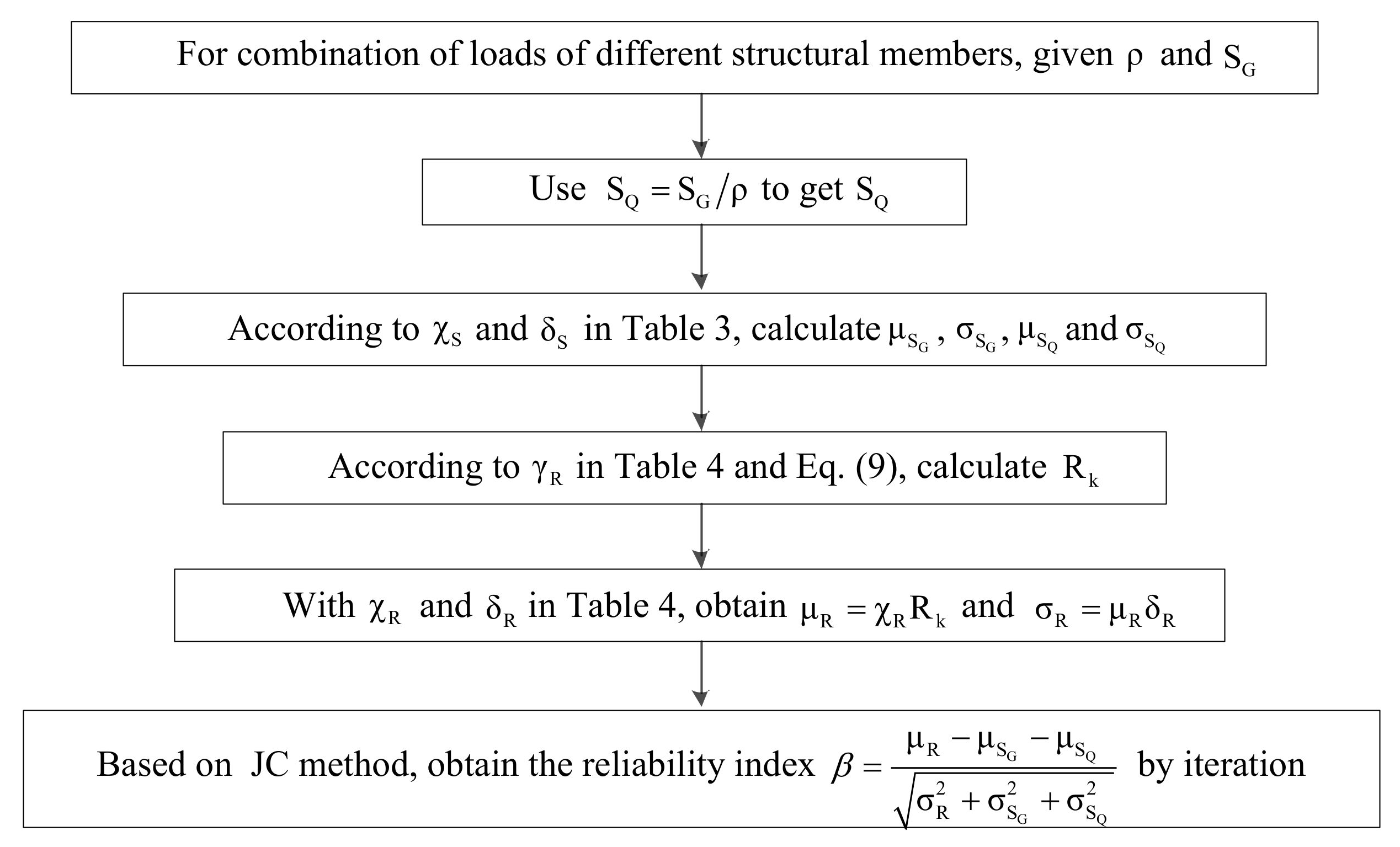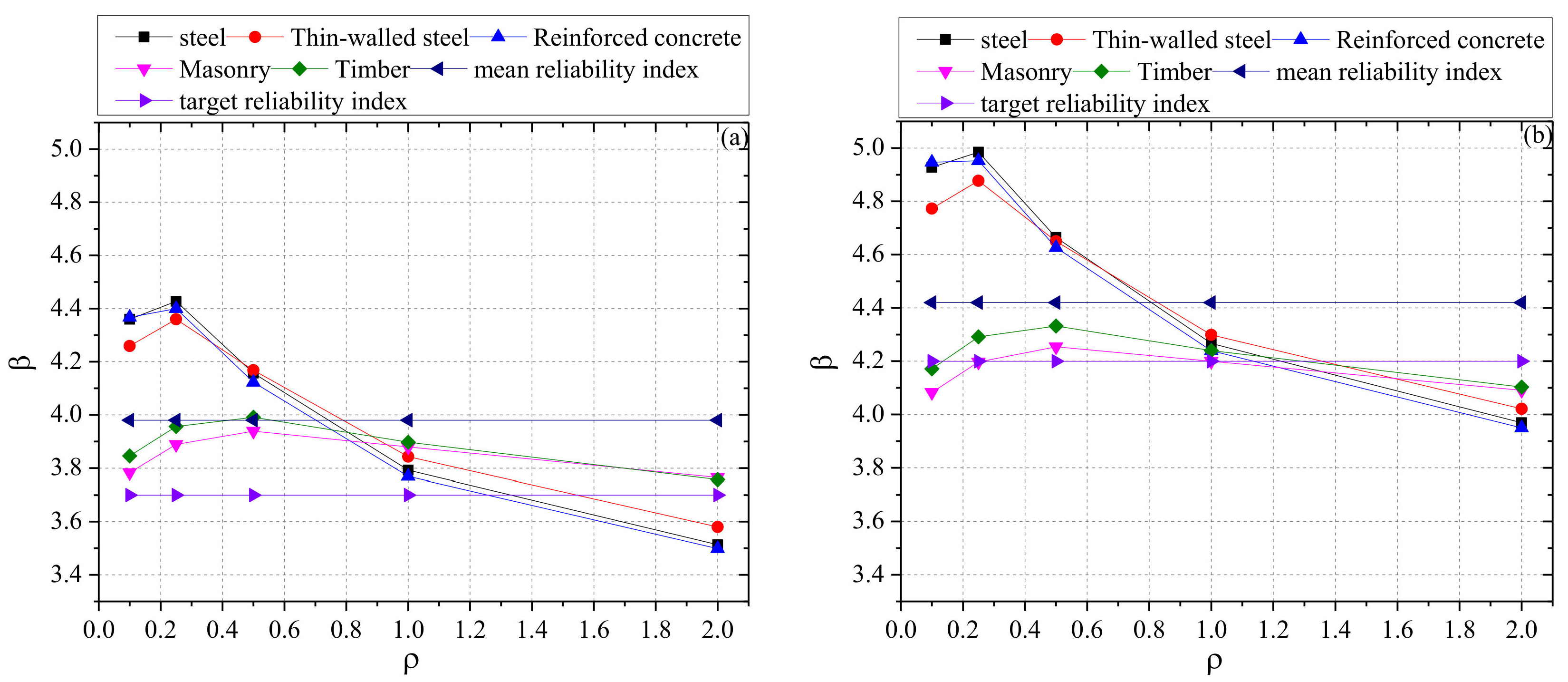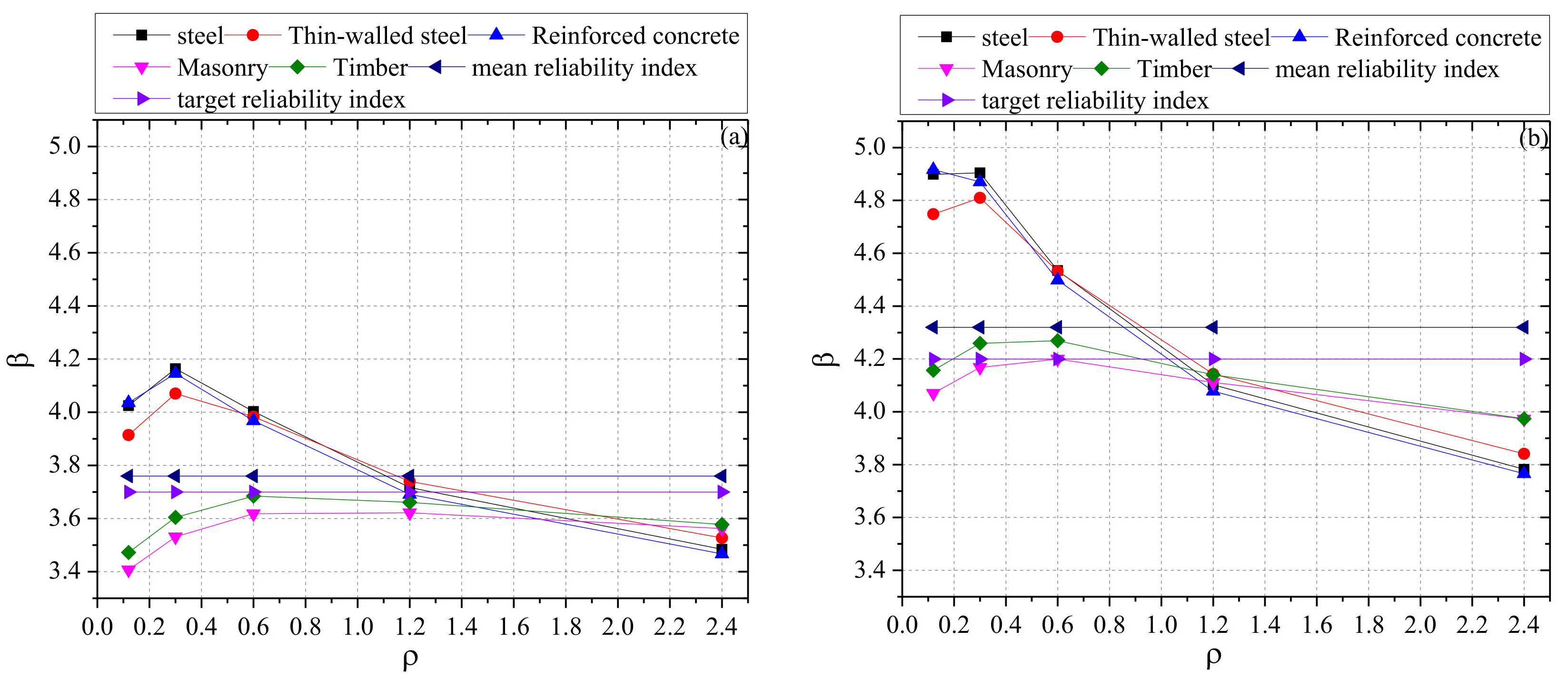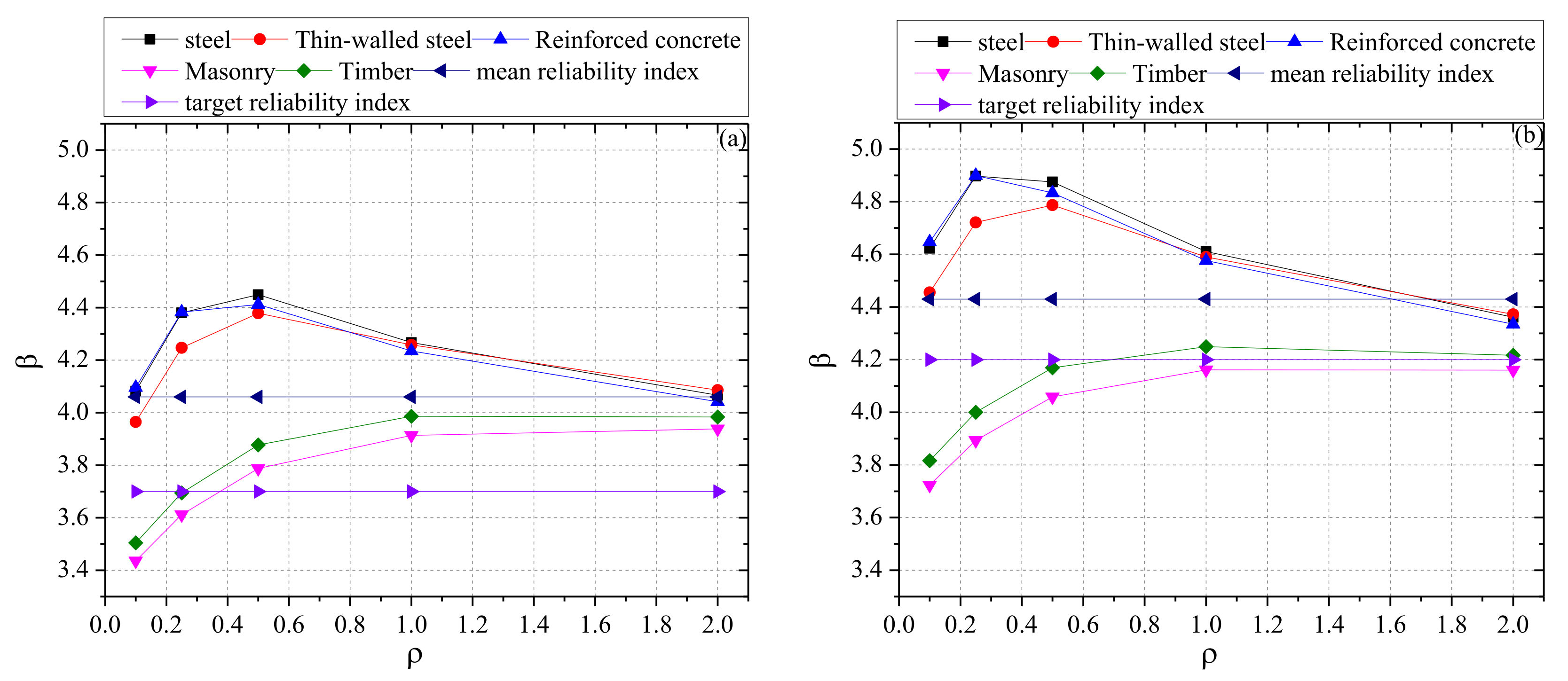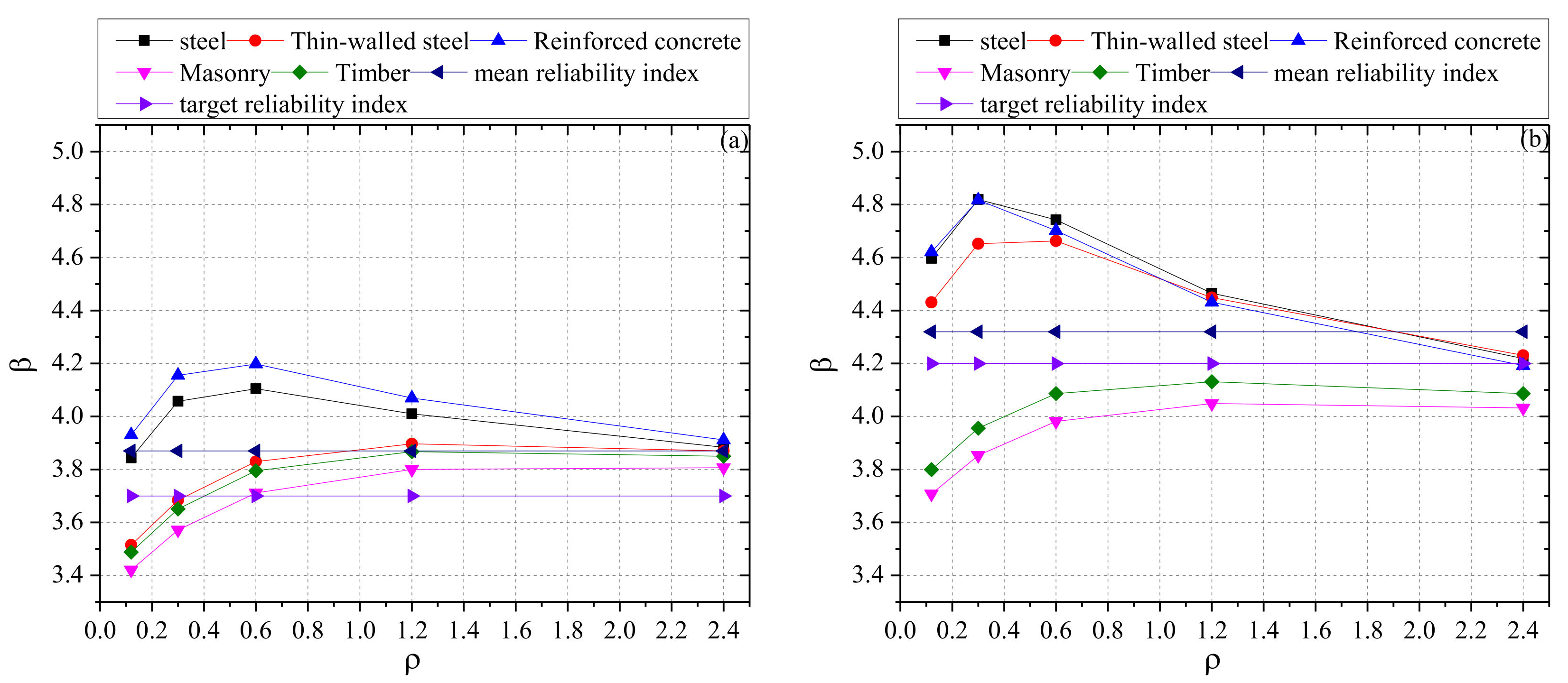1. Introduction
The design working life is understood as an assumed period of time for which a structure is to be used for its intended purpose without any major repair being necessary. Indicative values of design working life (10, 10–25, 15–30, 50 and 100 years for different types of new structures) are given in EN 1990:2002 [
1] (
Table 1). The reference period is understood as a chosen period of time used as a basis for statistically assessing the time variant basic random variables, and the corresponding probability of failure. The concept of reference period is therefore fundamentally different from the concept of design working life. Confusion is often caused when the difference between these two concepts is not recognized [
2]. Various national and international standards for building structures and other common structures specify a design working life of 50 years. The reference period of 50 years and the related target reliability values have been used in the derivation of the partial factors [
3], and the statistical parameters of loads in various national and international standards for building structures are all based on a design reference period of 50 years [
1,
3,
4]. When the design working life differs from the design reference period of 50 years, the relationship between the optimum target reliability levels of temporary structures, failure consequences, the design working life, and the discount rate has been clarified in [
5]. The simple relations of the target reliability as a function of the reference period considered are provided in [
6]. The reference design values and partial factors of basic variables are studied in [
7]. The partial factors under the design reference period of 60 years are obtained in [
8]. The durability model and the statistical properties of the model parameters of concrete structures for service life of 120 years are studied in [
9]. The Chinese standards indicate that the variable load adjustment factor for the design working life needs to be considered in the structural design expressions if the design working life differs from the design reference period of 50 years [
4,
10,
11].
The specific values of the variable load adjustment factors are given in Chinese structural reliability standards (GB50153-2008) [
10] and (GB50068-2018) [
11], and it is not stressed that these values are not suitable for wind load or snow load. The specific values of variable load adjustment factor in Chinese load code (GB50009-2012) [
4] are quoted from (GB50153-2008) [
10]. Meanwhile, the expressions and the calculated values of the variable load adjustment factors for live loads, wind load, and snow load under different design working lives, are shown in (GB50009-2012) [
4]. Although the code (GB50009-2012) [
4] gives the calculated values of the adjustment factors for wind and snow loads, it states that the variable load adjustment factors are only applicable to floor and roof live loads. The inconsistency of these provisions in the specifications will lead to doubts among designers. Furthermore, there are no clear specifications on the selection of the corresponding design parameters in design expressions in above-mentioned documents.
The Chinese load code (GB50009-2012) [
4] lists wind pressure and snow pressure values of return periods of 10, 50, and 100 years for all cities across China. Take Xi’an as an example: if the return period is 50 years, the basic wind pressure and basic snow pressure are taken to be 0.35 kN/m
2 and 0.25 kN/m
2, respectively; and if the return period is 100 years, the basic wind pressure and basic snow pressure are taken to be 0.4 kN/m
2 and 0.3 kN/m
2, respectively. For structural members designed for a working life of 100 years, the structural importance coefficient of 1.1 is taken in the design expression to increase all the load effects on the structural members [
12]. In this case, should the basic wind pressure and snow pressure values be taken with the return periods of 50 years or 100 years? If the return period of 50 years is used, what is the use of the wind and snow pressure values with a return period of 100 years in the code? If taken as the return period of 100 years, do we still need to consider the load adjustment factor? This issue was raised in the literature as early as 2014 [
13], but these issues are not clearly explained in the specification and there is no relevant literature on the subject. Thus, it is not clear how load parameters and load adjustment factors should be selected for a given design working life different from 50 years (say 100 years), which will lead to the trouble in the actual design process. For example, when selecting load parameters for a building structure designed for a working life of 100 years, literature [
14] adopts basic wind pressure and basic snow pressure with a return period of 100 years and considers the variable load adjustment factor for the design working life, while literature does not consider the load adjustment factor for the design working life [
15,
16].
Designing structures involves ensuring an adequate level of safety. The load and resistance factor design (LRFD) method has been widely used in building design. This is done by applying the appropriate set of partial factors for resistance and loads and the corresponding design parameters in design expressions. Reliability-based structural analysis of buildings and constructions made from conventional materials such as masonry, steel or concrete is commonly available in literatures. The theoretical background and basic principles for the reliability analysis and calculations can be found in [
17,
18,
19,
20,
21,
22,
23], which already has been applied in several studies [
24,
25,
26,
27,
28,
29]. Peng et al. [
24] studied the reliability of long span structure under wind and snow loading, and their results indicated that the equivalent extreme-value of element stress of the structure subjected to the dead load and the 100-year return period of wind and snow loads is far less than the allowable value, and the long-span building structure is therefore safe enough. The probability of structural failure by use of design standards for assessing marine operations is studied using structural reliability analyses to shed light on the implicit reliability levels of such standards. Natskår Asle et al. [
25] presented a structural reliability approach to accommodate the uncertainties affecting design checks. By applying the appropriate set of partial factor for strength and partial factors for actions in accordance with the recommendations of the Eurocodes. Joanna Zięba et al. [
26] presents an analysis of the reliability of a compressive masonry structure on the example of a wall fragment made of silicate blocks, and the relationship between partial factors applied to actions in various configurations and factors for the compressive strength of masonry was investigated. Considering samples generated by Latin Hypercube Sampling (LHS), the appropriate target reliability levels based on simulations of different scaffold design situations for facade scaffolds were proposed, based on which partial factors are determined [
27]. The appropriate probability distribution for annual maximum ground snow loads are studied in detail based on the samples of snow loads on the ground in [
28]. Then, the reliability of members of steel roof structures subjected to snow load at four representative sites in China is investigated, and it is found that the probability distribution function and parameter estimation method for ground snow loads have a great influence on reliability assessment results. Zhang et al. [
29] investigated the resistance uncertainty of the membrane material, proposed partial factors for the dimensioning of membrane structures and evaluated the obtained reliability index. For USL the membrane strength was considered. Zhang et al. used three different reliability analysis methods, the central point method [
30], the Rackwitz-Fiessler method [
31] and the response surface method [
32] in combination with Monte Carlo simulations [
33]. It was observed that the calculated reliability indexes for all cases meet the specified target reliability index from the unified standard of reliability design of engineering structures of China [
10]. Because there does not yet exist a unified design approach for membrane structures as is available for conventional buildings. In [
34], the partial factors for prestress, snow load and wind uplift load are calibrated, for the design of a 6 m by 6 m hyper-membrane structure. It can be stated that there is a need to adjust the common calibration methods to the application to tensile membrane structures.
The discussed article applied reliability analysis methods to structural members in order to determine the design parameters of the snow load and wind load in the design expressions of the members designed for working life of 100 years and to provide guidance for the specification in actual design. For structural members designed for working life of 100 years, 14 representative structural members were selected to calculate their partial factors of resistance. Considering two simple combinations (dead load and wind load, dead load and snow load) and common load effect ratios, the reliability analysis of each member are carried out according to the load partial factor in China’s old code (GB50153-2008) [
10] and new code (GB50068-2018) [
11]. The research can clarify the reliability levels implied by using different design parameters and eliminate the doubts of designers, which can better meet the needs of actual design.
3. Reliability Analysis of Structural Members
Reliability of structural members subjected to snow load or wind load can be defined by the limit state function as follows [
28]:
where
and
are structural resistance and dead load on structural members, which are assumed to not change with time;
is the maximum live load on structural members during the design working life;
and
are the conversion coefficients of load to effect for dead load and live load, respectively.
For the ultimate limit states, considering the combination of dead and live load (snow load or wind load), the design value of load effect can be determined by Equation (8), the required characteristic value of structural resistance can be determined by Equation (9):
where
,
and
are the characteristic values of the resistance, the effect of dead load and the effect of live load, respectively;
,
and
are the partial factors of the resistance, the dead load and the live load, respectively;
is the structural importance coefficient, when the design working life is 100 years, it may be taken as 1.1;
is the variable load adjustment factor for the design working life. The combinations of loads are dead load + snow load and dead load + wind load. For the snow load and wind load of a building structure designed for working life of 100 years, 2 different conditions are initially assumed. The two conditions are: ① the basic snow pressure or wind pressure with a return period of 50 years is adopted and the variable load adjustment factor for the design working life is considered in the design expression. And the ratios of the snow or wind load effect to dead load effect
are 0.1, 0.25, 0.5, 1.0, 2.0; ② the basic snow pressure or wind pressure with a return period of 100 years is adopted and the variable load adjustment factor for the design working life is not considered in the design expression. Because the ratios of the 100 years wind or snow pressure R100 to the 50 years wind or snow pressure R50 is about 1.1~1.3 for all cities in China. So the ratios of the snow or wind load effect to dead load effect can be taken as
, that is, 0.12, 0.3, 0.6, 1.2, 2.4. The reliability analysis of each member are carried out according to the load partial factor in China’s old code (GB50153-2008) [
10] and new code (GB50068-2018) [
11]. The flowchart for the calculation of the reliability index of the structural members is shown in
Figure 1. The reliability indexes of members under partial factors in (GB50153-2008) [
10] and (GB50068-2018) [
11] based on 50 years snow pressure are shown in
Table 8 and
Table 9.
Figure 2 shows the corresponding variation trend of reliability indexes based on 50 years snow pressure. The reliability indexes of members of partial factors in (GB50153-2008) [
10] and (GB50068-2018) [
11] based on 100 years snow pressure are shown in
Table 10 and
Table 11.
Figure 3 shows the corresponding variation trend of reliability indexes based on 100 years snow pressure.
The analysis indicates that when the basic snow pressure with a return period of 50 years is adopted and the variable load adjustment factor for the design working life of 1.1 is considered in the design expression, the average reliability index of 3.98 is much higher than the target reliability index of 3.7 with the partial factors in (GB50153-2008) [
10] and the average reliability index of 4.42 is much higher than the target reliability index of 4.2 with the partial factors (GB50068-2018) [
11]. Apparently, the corresponding design is unreasonable from an economic point of view. When the basic snow pressure with a return period of 100 years is adopted and the variable load adjustment factor for the design working life is not considered in the design expression, the average reliability index of 3.76 is much closer to the target reliability index of 3.7 with the partial factors in (GB50153-2008) [
10] and the average reliability index of 4.32 is much closer to the target reliability index of 4.2 with the partial factors (GB50068-2018) [
11]. This is more in line with the design principles of safety and economy in structural design. The similar results and conclusions can be obtained for wind load, the reliability indexes and the corresponding variation trend of reliability indexes are shown in
Table 12,
Table 13,
Table 14,
Table 15 and in
Figure 4,
Figure 5.
